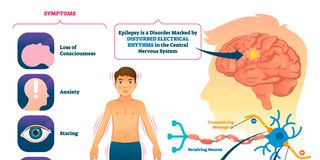New gene therapy offers relief to epileptic children

An illustration of an epileptic child. Scientists have developed a new form of gene therapy for treating drug-resistant epilepsy.
What you need to know:
- Globally, at least five million people are diagnosed with epilepsy annually, with the number rising to 139 in every 100,000 individuals in low- and middle-income countries.
- This is a huge contrast compared to high income countries where 49 per 100,000 are diagnosed with epilepsy yearly.
Parents of epileptic children can now breathe a sigh of relief after scientists developed a new form of gene therapy for treating drug-resistant epilepsy.
Drug resistant epilepsy in children, also known as Focal Cortical Dysplasia (FCD), occurs as a result of abnormal brain cell organisation and development.
FCD triggers frequent seizures; resulting in difficulties in learning and even death. Presently, doctors treat FCD through surgery, where they get rid of the faulty brain tissue. This method, though effective, is risky and may cause permanent damage to the brain. This is why the gene altering drug that has been developed by scientists at the University College London (UCL) comes as a relief.
According to experts based at UCL led by Dr Vincent Magloire, the new treatment regimen could be distributed to thousands of children currently suffering from severe, uncontrolled seizures. “The drug could tremendously save lives by reducing the number of seizures in many children worldwide,” Dr Magloire assures.
Prof Dimitri Kullmann, a neurologist at UCL, adds that plans are underway for clinical human trials that are anticipated to start in the next five years.
According to the National Epilepsy Coordination Committee, two in every one 100 people are epileptic in Kenya. Rural areas have a higher prevalence than urban areas, which is mainly attributed to risk factors such as brain infections that are left untreated. Gaps in epilepsy care range from lack of access to care and delayed diagnosis, to delayed treatment and lack of treatment. This has resulted in increased cases aggravated by rampant discrimination and stigma.
It is against this backdrop that the country joined the world on March 26 to mark this year’s Epilepsy Awareness Day also known as Purple Day, themed “LetsTalkAboutEpilepsy”.
The event focused on eradicating stigma, fear and shame linked to epilepsy as well as creating awareness by encouraging open talks in schools, workplaces among others.
Globally, at least five million people are diagnosed with epilepsy annually, with the number rising to 139 in every 100,000 individuals in low- and middle-income countries. This is a huge contrast compared to high income countries where 49 per 100,000 are diagnosed with epilepsy yearly.
The high prevalence rate in developing countries, including Kenya, has been linked to birth related injuries, high incidence of road traffic injuries and malaria (neurocysticercosis).
Other factors include variations in the availability of accessible healthcare, availability of preventive health programmes and medical infrastructure.
The latest report by the World Health Organization highlights that epilepsy is a long-term, non-communicable brain disease which affects people regardless of age, with nearly 50 million globally being epileptic.
The National Health Service in the UK points out that over the years, they have been deploying effective drugs, thus enabling epileptic patients to experience few to no seizures.
However, statistics show that about a third of the patients do not respond to these medicines, which includes drug-resistant epilepsy that affects nearly 35,000 children and young people.
Brain cells are designed to form layers that are organised to enable smooth travel of electrical impulses between brain parts.
In patients with FCD, however, the layers which are responsible for planning and making decisions are all jumbled up, therefore distorting signals and causing seizures, UCL experts explain.
“Three quarters of epilepsy survivors in low income countries do not get the necessary treatment,” states WHO.
The global health authority further notes that compared to the general population, epileptic people are up to three times more likely to die prematurely but with proper diagnosis and treatment, up to 70 per cent can enjoy seizure-free lives.





